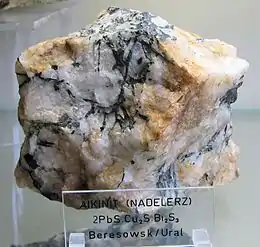Aikinite
Aikinite is a sulfide mineral of lead, copper and bismuth with formula PbCuBiS3. It forms black to grey or reddish brown acicular orthorhombic crystals with a Mohs hardness of 2 to 2.5 and a specific gravity of 6.1 to 6.8. It was originally found in 1843 in the Beryozovskoye deposit, Ural Mountains. It is named after Arthur Aikin (1773–1854), an English geologist.
| Aikinite | |
|---|---|
 | |
| General | |
| Category | Sulfide mineral |
| Formula (repeating unit) | PbCuBiS3 |
| Strunz classification | 2.HB.05a |
| Dana classification | 3.4.5.1 |
| Crystal system | Orthorhombic |
| Crystal class | Dipyramidal (mmm) H-M symbol: (2/m 2/m 2/m) |
| Space group | Pnma |
| Unit cell | a = 11.297, b = 11.654 c = 4.061 [Å], Z = 4 |
| Identification | |
| Formula mass | 575.92 g/mol |
| Color | Lead gray, grayish black, reddish brown |
| Crystal habit | Acicular, massive |
| Cleavage | {010} indistinct |
| Mohs scale hardness | 2-2.5 |
| Luster | Metallic |
| Streak | Grayish black |
| Diaphaneity | Opaque |
| Specific gravity | 6.1–6.8, Average = 6.44 |
| Other characteristics | Not radioactive |
| References | [1][2] |
It has been found in Western Tasmania, in mines located near Dundas, Tasmania
References
| Look up aikinite in Wiktionary, the free dictionary. |
This article is issued from Wikipedia. The text is licensed under Creative Commons - Attribution - Sharealike. Additional terms may apply for the media files.
